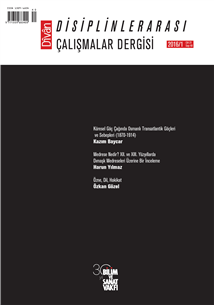40
Bu sayısında Dîvân 19. yüzyıl Osmanlı Suriyesinden Amerika kıtasına göçleri, 12-13. yüzyılarda Dımaşk’ta kurulan medreseleri ve özne, dil ve hakikat arasındaki ilişkiyi konu alan üç makaleyi okurlarına sunuyor. Muhtelif akademik alanlardaki güncel literatürü konu alan değerlendirme yazıları ise ilgililerini bekleyen bir diğer kısım.
Articles
From the late nineteenth century up to World War I, approximately half a million Ottoman citizens immigrated to the Americas from the province of Greater Syria. This article examines the fundamental reasons for this mass emigration in the light of the Ottoman archives and historical migration records of Argentina and the United States. While these migration movements have traditionally been depicted as the consequence of civil war and local unrest in the empire in the 1860s, this article argues that social and economic factors—namely population growth, economic deterioration, and military conscription—played the determinant role in the exodus of Ottoman Syrians.
Kazım BaycarIn Islamic history, there are different views on the emergence and spread of madrasas. The early literature on madrasas centered on the Baghdad Nizamiyya Madrasa, but in recent years new studies have begun to focus on different regions and periods in the Islamic world. While this move has the potential to shed light on hitherto underappreciated aspects of madrasa development, it also runs the risk of misrepresenting that development if due attention is not paid to the important role played by political context in the way madrasas developed in different times and places. Through a close examination of the madrasas of Damascus in the twelfth and thirteenth centuries, this article calls a number of traditional understandings of madrasas into question. Examining the emergence, spread, and function of madrasas in this period, it argues that one of the most important consequences of the rise of madrasas concerned the relationship between political-power holders and the ulama. The former aimed to design a society based on the ulama’s social and religious power, and to gain public support and strengthen their legitimacy. For the ulama, the madrasa meant the extension of opportunities, a place to stay, and a sustainable livelihood where they could devote themselves to scholarly activities. For this reason, madrasa appointments were highly valued by the ulama. This article therefore sheds light upon the political context rather than the religious and scholarly dimensions of madrasas.
Harun Yılmaz“Truth” is not something purely theoretical, abstract, or detached from life. It reveals itself to a person directly, through his or her subjective experience. A subject’s experience of truth occurs through a kind of care, manifested in and through language. Language is not only a tool, but also a medium in which a subject exists. The philosophy of the twentieth century was fundamentally language-oriented. This study also prefers a language-oriented philosophical approach to ratio-oriented one. It aims to examine the relationship between truth and subjectivity in and through language, namely Turkish. It tries to establish a relationship between hakikat (truth) and (1) subjectivity via the concept of authenticity, (2) society via the concepts of equity and law, and (3) God through the concept of Truth (Hakk). It further attempts to set out necessary and intrinsic connections between these concepts. Another aim of this study is to relate the etymological-semantic level to the metaphysical one and to identify the manifestations of the concept of hakikat in language. Here, what is in question is not the term’s definition in the classical approach, but its description in the phenomenological approach. This paper thus tries to exhibit how truth (hakikat) appears in the experience of the subject by means of its effects or effective manifestations. Hakikat is first and foremost, prior to any theoretical or speculative investigation, something experienced, and the primary testament to this fact is language itself.
Özkan GÖZEL





